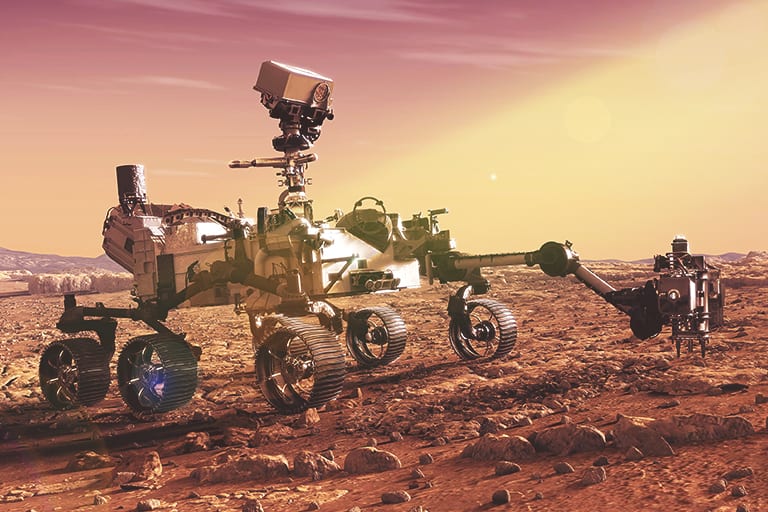Motiv Technology to Reach Mars as part of Mars 2020 Mission
After traveling for about 7 months and nearly 300 million miles, NASA’s Mars 2020 Perseverance Rover is scheduled to land on the red planet. Once it’s landed, the rover will rely on several technologies developed by Motiv Space Systems, a space robotics company based in Pasadena, California.
On Thursday, just after noon Pacific Time, the Perseverance Rover is scheduled to plunge through the Martian atmosphere. It should reach speeds of over 12,000 mph before slowing down with the aid of a parachute, and landing in the Jezero Crater. Once there, it will embark on one of the most ambitious missions in the history of NASA’s Mars exploration program: drilling, analyzing, and, eventually, on a future mission, returning samples of Martian rock and soil to Earth.
On this mission, if all goes according to plan, those samples will be returned to Earth for further analysis around 2030.
“The stakes are always high when you’re dealing with space robotics,” said Chris Thayer, President and CEO of Motiv Space Systems, “but that’s doubly true when a mission a decade in the future is depending on your mission’s success today.”
At 7 feet long, the Perseverance’s primary robotic arm is the largest, most visible component built for the rover by Motiv and delivered to NASA’s Jet Propulsion Laboratory (JPL). During the mission, the arm will allow the rover to drill through Martian rocks to collect core samples, operate scientific instruments that will take images and perform analysis of the Martian surface, and deposit samples in the rover’s chassis.
While the other systems provided by Motiv aren’t as large or visible, they’re equally critical in allowing the rover to complete its mission.
The rover’s Mastcam-Z cameras, featuring focus and zoom mechanisms developed by Motiv Space Systems, will bring depth and color to the images collected by the rover during its mission, allowing vivid HD video to be sent back to Earth.
A filter wheel developed by Motiv for the same Mastcam-Z instrument allows scientists to select from 8 optical elements, each designed to filter a specific wavelength of light to allow for important scientific observations.
Finally, a revolutionary force-torque sensor developed by Motiv exclusively for the rover will allow the Perseverance’s robotic arm to get valuable real-time feedback as it drills for, collects, and manipulates samples on the Martian surface.
“During its mission,” said Thayer, “the Perseverance Rover will be able to do things no previous Mars rover could do, thanks to the unique technology it has onboard.”
“As valuable as the scientific insights we gain this in the coming weeks from the rover are likely to be, I expect to pale in comparison to what we can learn about Mars once we get the samples back on earth.”
If all goes according to plan, the Perseverance Rover should be in operation on the surface of the planet for at least one Mars year, equivalent to 687 days here on Earth. In the meantime, Motiv is already collaborating with NASA’s JPL on another project, a robotic arm that can operate in the coldest reaches of space, like the dark side of our own moon, or even on the surface of our solar system’s icy moons.
“While Perseverance is going to work on Mars,” said Thayer, “our teams are already working on robotics that will be deployed with NASA and private space missions in years to come.”
Learn about Motiv’s contribution to the Mars 2020 Perseverance Rover for NASA’s Jet Propulsion Laboratory.
About Motiv Space Systems
Headquartered in Pasadena, California, Motiv Space Systems takes pride in designing both ground and space-rated robotic solutions for a range of application demands. As the respected team that provided the robotic arm for NASA’s JPL Mars 2020 Perseverance rover, Motiv Space Systems leverages technologies from both Earth and space to offer cost-effective solutions for robotics in a variety of industries. Their newly launched xLink™ Space-Rated Modular Robotic Arm System is highly capable and has a profoundly flexible architecture, redefining the market for space-rated robotic arms in terms of both cost and capabilities.
Contact: Tom McCarthy, VP of Business Development, info@motivss.com
